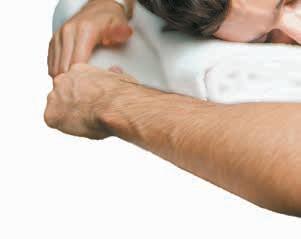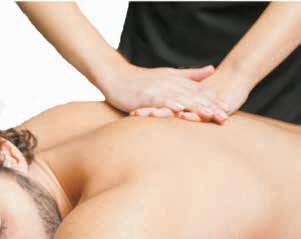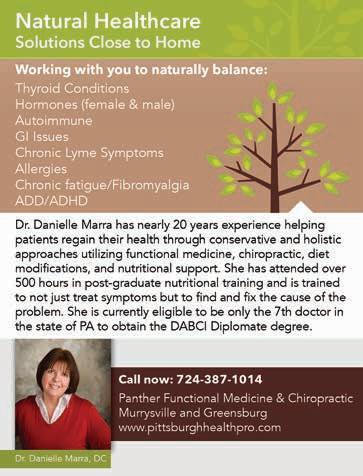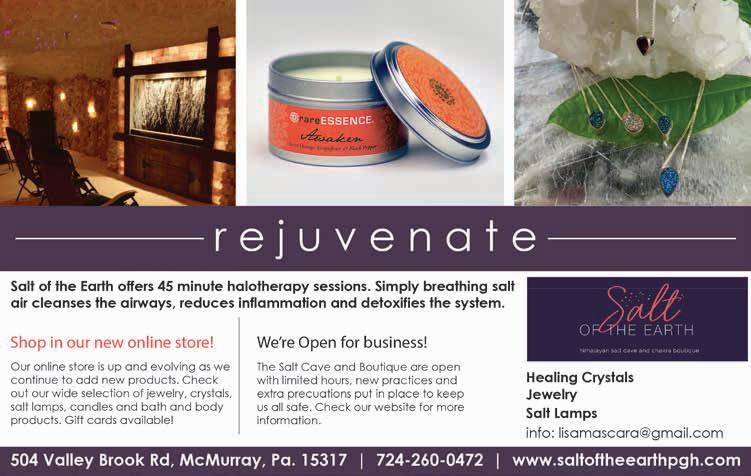
9 minute read
STAY FIT WITH
Stay Fit with Bodywork Therapy
Enhance Workout Performance and Recovery with Massage
Advertisement
by Marlaina Donato

Therapeutic massage and other bodywork modalities are well-known stress-busters, but they can also hasten recovery aft er a workout or injury. A little restorative TLC with a bodywork practitioner before or aft er exercise can combat post-workout soreness and stiff ness, maximizing our fi tness investments in and out of the gym.
Approaches such as Swedish, deep tissue and sports massages, and myofascial trigger point release therapy can boost both blood and lymphatic circulation, giving soft tissues a vital shot of cellular nutrition. Massage modalities aff ect biochemical processes and on the deepest level, mitochondria—the cell’s energy-producing engines. Research from 2015 published in the journal Medicine & Science in Sports & Exercise shows that massage immediately following injury due to resistance training encourages tissue regeneration.
Tailored Tools
“In the context of exercise, someone who trains three to fi ve times per week at a high intensity will likely have a higher level of fi tness. However, the demand placed on the soft tissue structures will equally be high, and may require more treatment to off set this. Th is may vary from once a week to once a month,” says Andy Stanbury, head of soft tissue therapy at Pure Sports Medicine, a London clinic for sports injuries.
Aft er working with high performance athletes for 15 years, he always asks, “What do I need to add to improve a patient’s fi tness or performance?” For a patient that wants to improve fi tness by running, “I would want to optimize their range of movement and stimulate the nervous system in readiness to exercise. I may look to use some myofascial release techniques, active release therapy, instrument-assisted soft tissue mobilization or muscle energy techniques. Th is would of course take place before the run.” For post-run recovery, Stanbury suggests more relaxing modalities, such as gentle massage, combined with breathwork.
Th e Fascia Factor
Fascia, a network of connective tissue, wraps the body in protective layers from the most superfi cial muscle to the deepest organs and plays a central role in fl exibility. Th is complex netting can become stuck due to inactivity, injury or surgery. Keeping it supple is vital for everyone.
Bodywork like myofascial release that targets trigger points—knots of tension— can help to ramp up postoperative and overall injury recovery. “Myofascial release is a technique used to reduce the tension in the fascial membrane. Slowly stretching the fascia will unwind and reduce the pressure on the muscles and nerves, reducing pain and creating range of motion and fl exibility,” explains Anthony Hansen, a myofascial release therapist at Th erapy on the Gulf, in Naples, Florida.
Hansen, who specializes in a “fast release” technique, emphasizes the impor-


tance of a gentle approach. “Trigger points are caused by cellular debris encapsulated by the fascia, so it’s much better to stretch it loose than it is to force it. Normally, it takes about three to fi ve sessions, depending on the condition of the patient, for the fascial system to unwind before the patient will feel relief.”
Active trigger points refer, or radiate, pain elsewhere in the body while latent points tend to be more localized and are sore when compressed. “From a whole-body perspective and when we put this in the context of fascial planes, restoration of effi cient movement is key, particularly post-surgery and when progressing training load,” says Stanbury. “However, this is not just movement of the body (muscles), but movement of blood, lymph and energy.”
A supple, tension-free body helps deter and bounce back from injuries. Regular bodywork, especially Swedish and deep tissue massage, fosters muscle recovery and helps prevent future issues. Self-massage using foam rollers and massage balls or canes can also be very helpful.
Bodywork off ers full-spectrum perks, points out Stanbury, including “improved tissue mobility and elasticity, more effi cient blood circulation and reduced anxiety and stress. Th is will, in turn, help promote better sleep, which is, of course, where we recover best.”
Marlaina Donato is a body-mind-spirit author and composer/ recording artist. Connect at AutumnEmbersMusic.com.




Natural Mama
Holistic Approaches to a Healthy Pregnancy
by Julie Peterson
During her fi rst pregnancy, Sarah Wallace, a former registered nurse in Atlanta, was chronically anemic. “I was so tired I would fall asleep while I was eating dinner,” she says. Th at pregnancy resulted in a baby with a low birth weight. Fortunately, Wallace learned more about nutrition and wellness. Her now 4-year-old has caught up to the growth charts and is thriving, and her next pregnancy went smoothly.
No matter how pregnancy is counted—280 days, 40 weeks or three trimesters—mama and baby share blood, nutrition and air for the duration. “Taking a holistic path before and during pregnancy is about embracing the nature of our bodies and committing to maintaining all aspects of wellness during this journey,” says Nancy Peplinsky, founder of the Holistic Moms Network, based in Caldwell, New Jersey.
Nutrition for Two
Th e right foods nourish the growing baby, the placenta and the mother’s increasing blood volume, maintaining the mother’s body during the complex mission. Whole foods rather than processed are best. Th e Whole 9 Months: A Week-By-Week Pregnancy Nutrition Guide with Recipes for a Healthy Start, by integrative obstetrician-gynecologist (OB-GYN) Jennifer Lang and dietitian Dana Angelo White, makes it easier to select the proper nutrients along the way and provides ways to deal with nausea and cravings.
Choose organic foods when possible to reduce exposures to pesticides. If organic isn’t an option for every food, Th e Shopper’s Guide to Pesticides in Produce, from the Environmental Working Group (ewg.org), can be downloaded and taken to the market. Either avoid foods on the “Dirty Dozen” list or go organic for those items.
A high-quality prenatal vitamin fi lls nutrition gaps. Wallace saw a diff erence between her fi rst and second pregnancy by switching brands. “Th e fi rst time, I took generic prenatal vitamins. With the second pregnancy, I found whole-food supplements. I never got that exhaustion, and my second baby was a healthy weight,” she says.
“Research has shown that healthy nutrition during pregnancy improves outcomes for mom and baby, while unhealthy food choices can lead to premature childbirth, high-risk pregnancies and poor developmental outcomes in children,” says Peplinsky.
In addition to clean food, it’s important to reevaluate body care products and household cleaners for toxicity. Th e National Institute of Occupational Safety and Health has linked personal care and cleaning product ingredients to endocrine disruption, developmental and reproductive disorders, neurotoxicity and cancer.
Body Love
Kristen Burgess, in Fife Lake, Michigan, creator of the website NaturalBirthAnd BabyCare.com, teaches classes for moms-tobe. “[Exercise] helps your blood volume increase, brings plenty of oxygen to your baby, increases your stamina and endurance for labor (which is an athletic event), and perhaps best of all, keeps you feeling great,” she writes in her blog.
Options such as stretching, walking and prenatal yoga can be soothing for mom and baby. Burgess also advocates prenatal belly dancing to raise the heart rate “while bonding with your baby and relishing your beautiful pregnant form.”
Peplinsky notes, “A holistic approach to pregnancy also embraces integrative therapies such as meditation, yoga, acupuncture and chiropractic, which may assist in reducing stress, minimizing physical discomfort and joint pain, while improving overall life quality for mom and baby.”
Support Along the Way
A healthy pregnancy includes assistance. In the U.S., most women choose an OB-GYN, with just over 9 percent of 2017 births incorporating a midwife to support the mother before, during and sometimes aft er birth. A midwife is medically trained and, depending on state law, may off er gynecological examinations, birth control counseling and prescriptions. On her own or as an assistant to a doctor, she coaches the mother during labor and assists with the delivery, which may be in a home, birthing center or hospital. Th e American College of NurseMidwives, in Silver Spring, Maryland, off ers a midwife locator.
Another option is engaging a doula that focuses on emotional support for mom, her partner and the family during pregnancy and birth. During labor, she may off er massage, encouragement and breathing coaching. While doulas only provide non-medical care, they can off er evidence-based resources to inform decisionmaking. Th ere is a database to fi nd one at DoulaMatch.net.
Th ere are also books and apps to provide week-to-week details on pregnancy. Genevieve Howland, a childbirth educator in Destin, Florida, and author of Th e Mama Natural Week-by-Week Guide to Pregnancy and Childbirth, off ers a weekly article at MamaNatural. com about what’s going on with the developing baby and mother.
“Being a holistic mom is about connecting the mind, body and spirit, and approaching wellness with all three in mind,” adds Peplinsky. “Th e more we listen to our instincts and our needs, the more our health improves during childbearing and aft erwards.”
Julie Peterson writes about health and wellness. Reach out at JuliePeterson2222@gmail.com.
Planetary Signs and Sun Signs
by Anjali Soi
Popular astrology oft en consists of knowing your sun sign, with many people stating, “I’m an Aries” or “I’m a Scorpio” when a discussion about astrology begins. But many don’t know that they also have a moon sign and other planetary signs. Reading our sun sign horoscope or understanding our personality traits based on sun sign astrology defi nitely has validity, but this is just the very tip of the iceberg. When we were born, all of the planets, including the sun and the moon, were passing through certain signs that are different than but related to constellations relative to our position on Earth. Aries corresponds to the Aries constellation, Taurus to the Taurus constellation, and so on. For example, if we were born in May, then maybe we have the sun in Aries, the moon in Gemini, Mercury in Aries, Venus in Taurus, Mars in Sagittarius, Jupiter and Saturn in Scorpio and so on, with Uranus, Neptune and Pluto. These planetary signs will equally indicate your personality and aspects of your life just as much as your Sun sign. Th e planets represent aspects of our psyche and activate the signs, or our needs and qualities. Th e sun represents our wellbeing and what we come back to feel whole again. Th e moon represents our emotional and feeling body, while Mercury shows our thinking and communicating nature. Venus shows how we can achieve balance and the nature of our relationships, and Mars shows how we activate our conscious desires and ego. Knowing our planetary signs gives us a much more complete and accurate view of who we are and our life path to achieve a more holistic and integrated understanding.

Anjali Soi is the. owner of Sun Confl ict Solutions, in Pittsburgh and online. For more information, call 412-897-0809 or visit AnjaliSoi. com/astrology. See ad in the Community Resource Guide.










